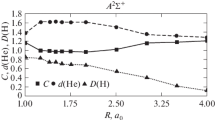Abstract
The static dipole polarizability α d, i for an arbitrary bound state i of the non-relativistic hydrogen-like atom has been known for a long time from, e.g; the second-order perturbation theory treatment of the Stark effect. A reliable result for the ground state requires both summation over the discrete spectrum and inclusion of the continuum contribution. This continuum contribution is known to decrease for excited states, but a systematic study of this decrease has not been available so far. We present here representative results from a systematic study of α d, i , which was performed as a first test of a new algorithm for the radial integrals involved. Partial sum approximations of the discrete contribution yield the total α d, i with a relative error of less than 1% for all states i with principal quantum number n≥5. Corresponding results for the relativistic case, for which the radial integral algorithm was developed, will be presented elsewhere.
Similar content being viewed by others
References
Epstein PS (1916) Ann Phys (Leipzig) 50:489
Pauli W (1926) Z Phys 36:336
Schrödinger E (1926) Ann Phys (Leipzig) 80:437
Wentzel G (1926) Z Phys 38:518
Waller I (1926) Z Phys 38:635
Epstein PS (1926) Phys Rev 28:695
Dalgarno A (1962) Adv Phys 11:281
Hirschfelder JO, Byers Brown W, Epstein ST (1964) Adv Quantum Chem 1:255
Schiff LI (1968) Quantum mechanics, 3rd ed. McGraw-Hill, New York
Zülicke L (1978) Quantenchemie – Ein Lehrgang. Band 1. Hüthig, Heidelberg (in German)
Landau LD, Lifschitz EM (1986) Lehrbuch der theoretischen Physik, Band III: Quantenmechanik, 9th ed. Akademie-Verlag, Berlin (in German)
Jhanwar BL, Meath WJ (1980) Mol Phys 40:713
Tanner AC, Thakkar AJ (1983) Int J Quantum Chem 24:345
Canuto S, Goscinski O (1979) Int J Quantum Chem 16:985
Bethe HA, Salpeter EE (1977) Quantum mechanics of one- and two-electron atoms. Plenum, New York
Hill RN (1996) In: Drake GWF (ed.) Atomic, molecular, & optical physics handbook. American Institute of Physics, Woodbury, New York, p 120
Park D (1960) Z Phys 159:155
Mayr K (1935) Math Z 39:597
Erdélyi A (1936) Math Z 40:693
Saad N, Hall RL (2003) J Phys A 36:7771
URL: http://www-gdz.sub.uni-goettingen.de/cgi-bin/digbib.cgi?PPN266833020
Erdélyi A, ed. (1954) Tables of integral transforms. vol. I. McGraw-Hill, New York
Gradshteyn IS, Ryzhik IM (1994) Table of integrals, series, and products. 5th ed. Academic Press, Boston
Prudnikov AP, Brychkov YuA, Marichev OI (1998) Integrals and series. vol. 3, 2nd printing Gordon & Breach, USA
Exton H (1976) Multiple hypergeometric functions and applications. Horwood, Chichester
Exton H (1978) Handbook of hypergeometric integrals: theory, applications, tables, computer programs. Horwood, Chichester
Magnus W, Oberhettinger F, Soni RP (1966) Formulas and theorems for the special functions of mathematical physics. 3rd ed. Springer, Berlin, Heidelberg, New York
Weissbluth M (1978) Atoms and molecules. Academic Press, New York
Inglis DR (1931) Phys Rev 38:862
Slater JC (1960) Quantum theory of atomic structure. vol. 1. McGraw-Hill, New York
Author information
Authors and Affiliations
Corresponding author
Additional information
Dedicated to Professor Hermann Stoll on the occasion of his 60th birthday
An erratum to this article is available at http://dx.doi.org/10.1007/s00214-005-0068-y.
Rights and permissions
About this article
Cite this article
Koch, V., Andrae, D. Discrete contributions to static dipole polarizabilities of excited bound states of non-relativistic hydrogen-like atoms. Theor Chem Acc 114, 380–386 (2005). https://doi.org/10.1007/s00214-005-0691-7
Received:
Accepted:
Published:
Issue Date:
DOI: https://doi.org/10.1007/s00214-005-0691-7




